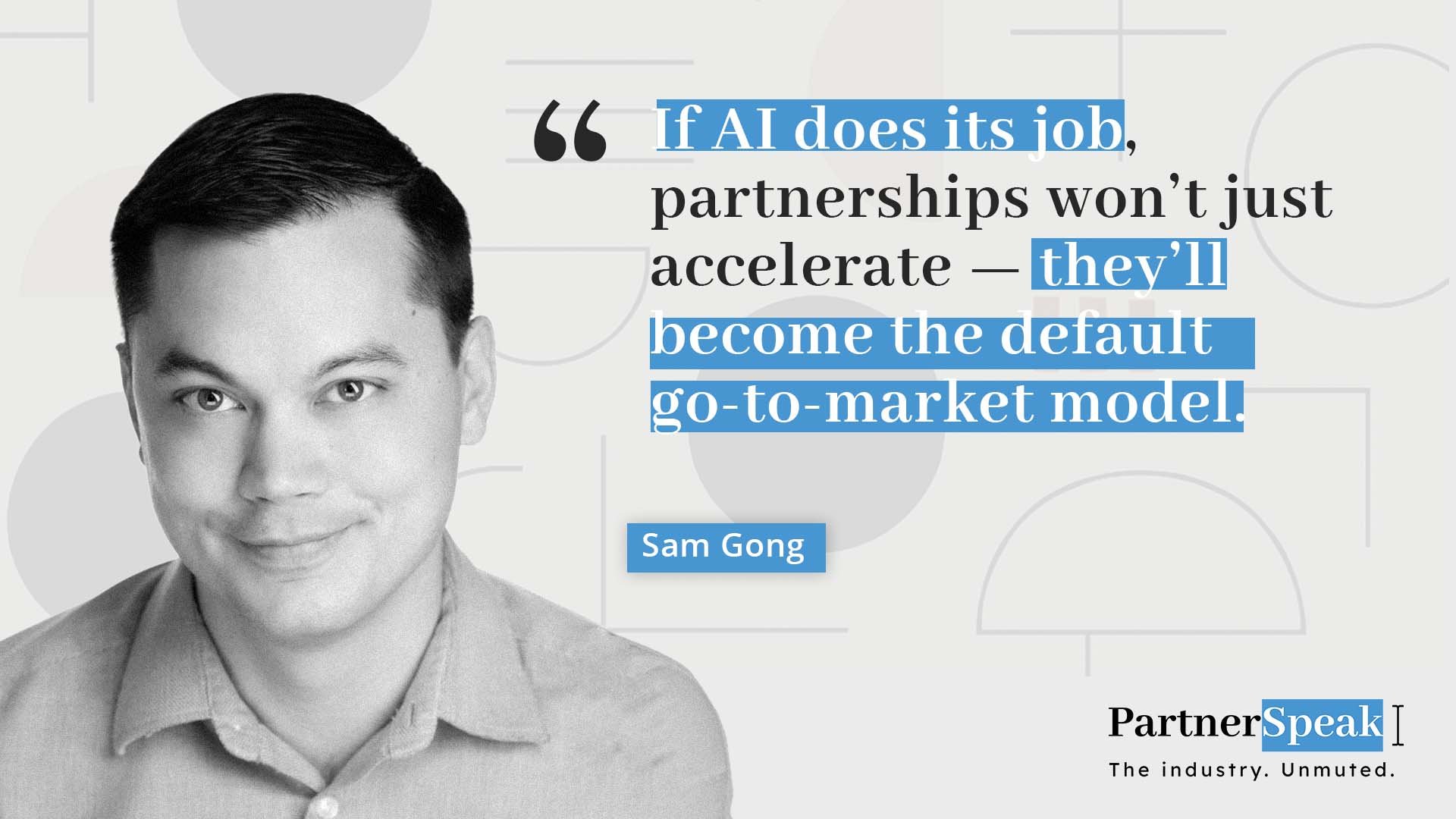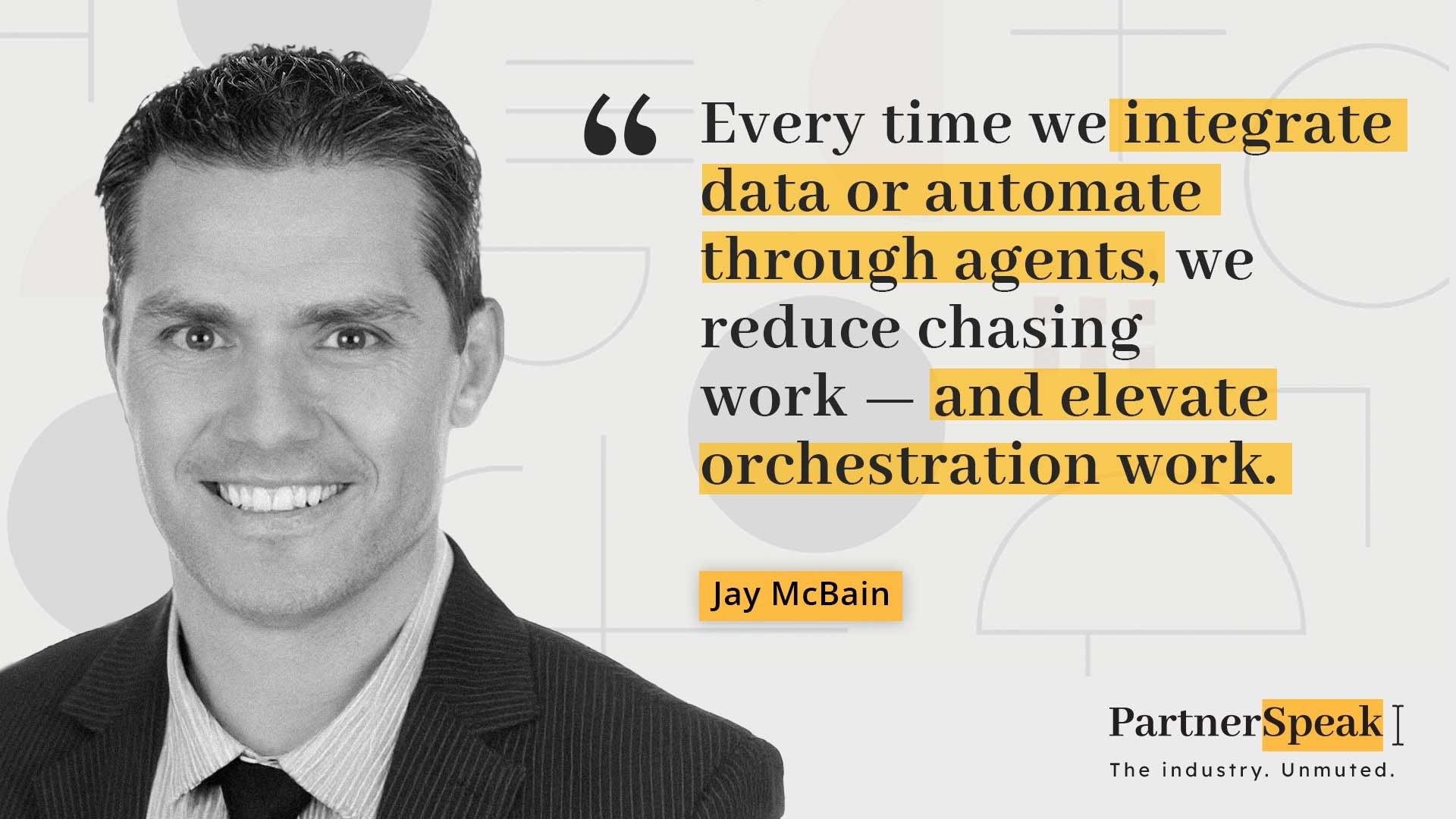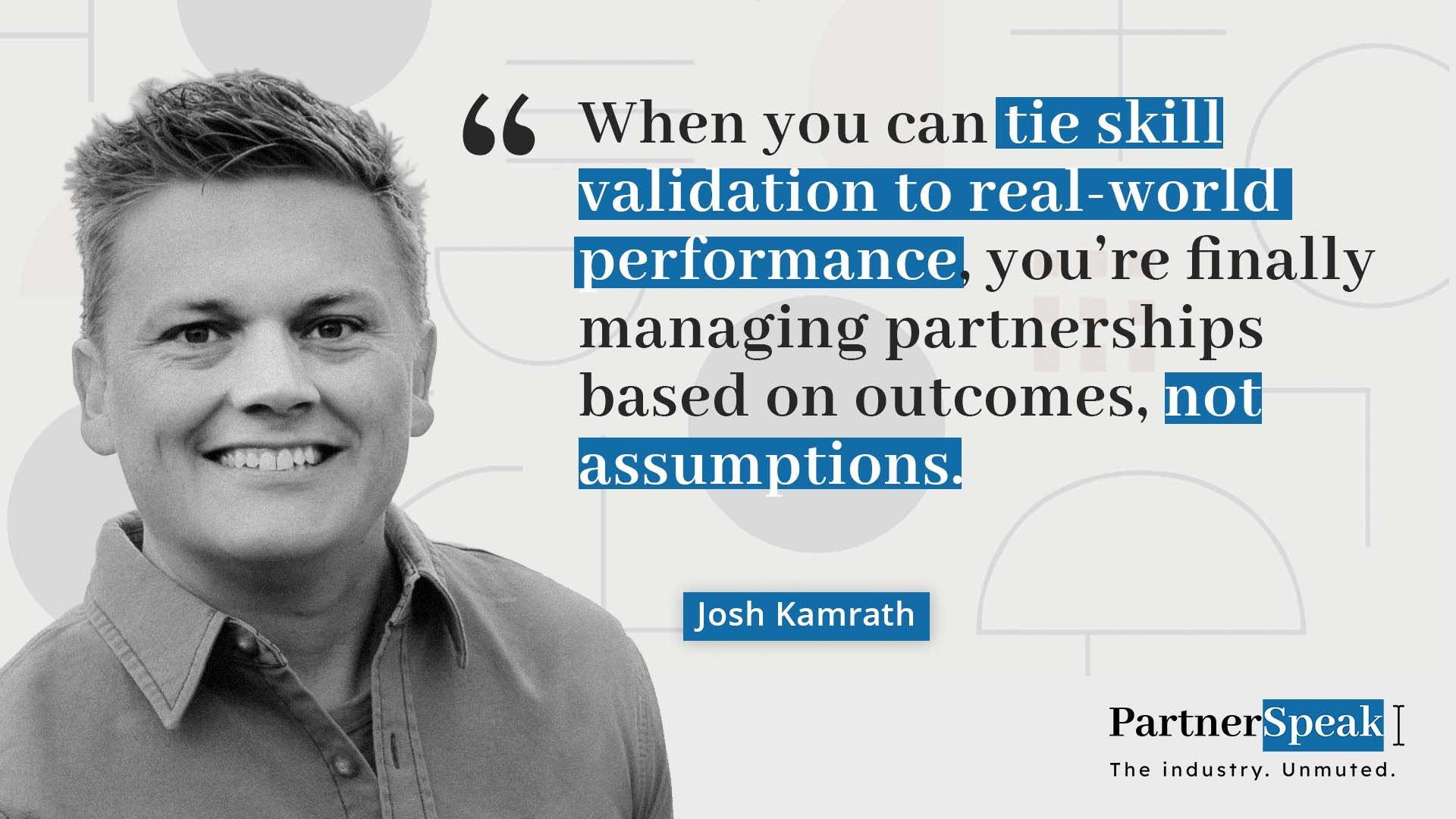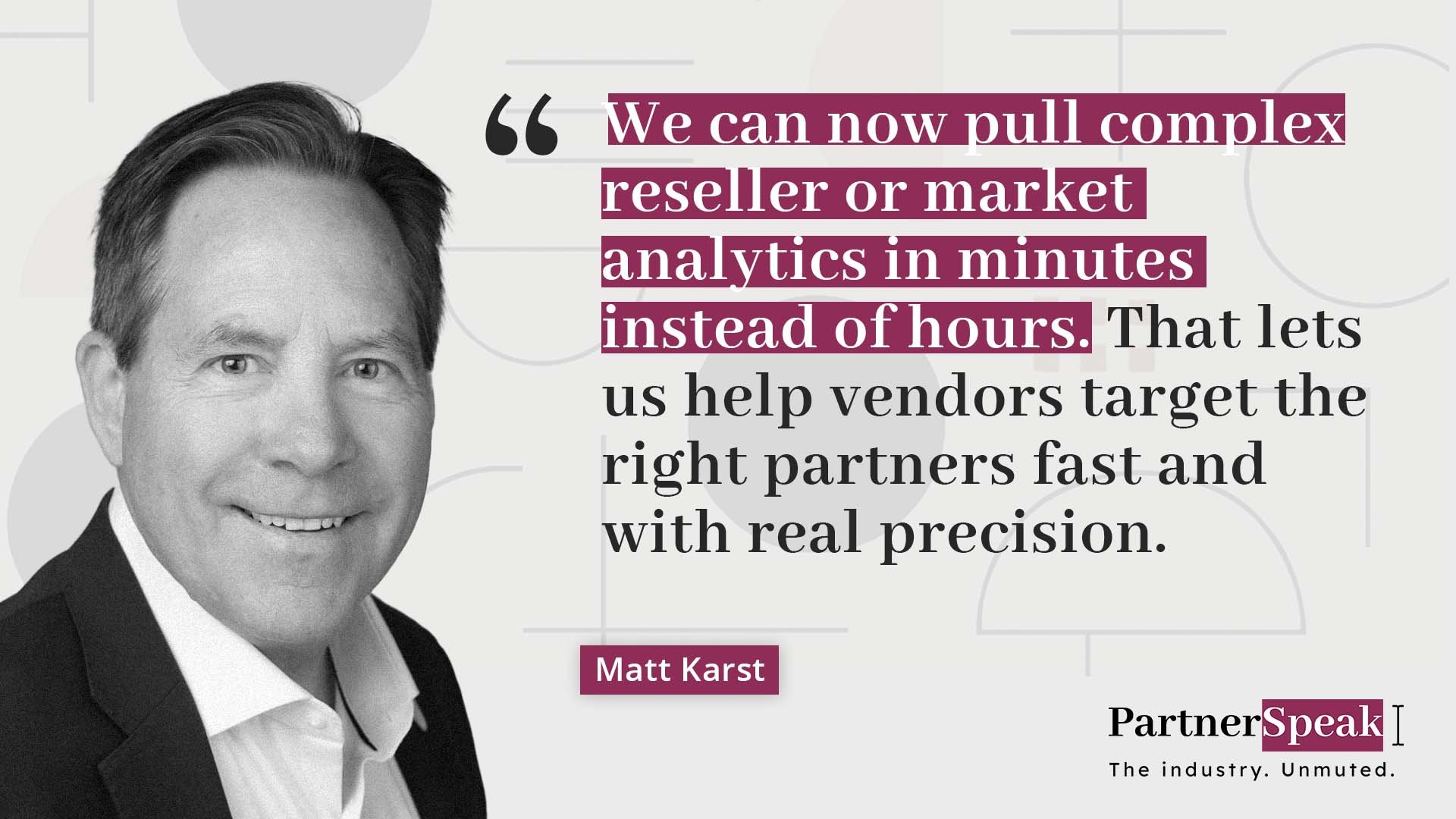AI isn’t just changing technology—it’s rewriting the partnership playbook.
We’re back with a new set of powerhouse voices in our PartnerSpeak: Ecosystem x AI series. In this first collection, Sam Gong of WorkSpan explores AI’s double impact, Jay McBain of Omdia (formerly Canalys) dissects the $7 trillion platform race, Josh Kamrath of Bongo redefines partner validation, and Matt Karst of TD SYNNEX shows how to turn AI chaos into channel clarity.
Together, they reveal how partnerships are powering the next era of intelligent go-to-market.
Sam Gong: AI’s Double Impact: Why Partnerships Will Anchor the Future
Few people have a sharper view of how technology and partnerships collide than Sam Gong, SVP of Marketing at WorkSpan — the platform powering co-selling and partner management for the world’s largest tech ecosystems. Sam sees artificial intelligence not just as a new tool, but as the inflection point that’s redefining how companies build, sell, and win customers together.
“AI has a two-sided impact on partnerships,” Sam told me. “It creates the need for them — and makes them possible to manage.”
The Speed Shift
Sam calls this his two big bets — one on AI as a force that accelerates the need for partnerships, and another on AI as the only way to manage the complexity that comes with them.
“AI is creating the need for partnerships faster than any technology before it,” he said. “And it’s going to become essential for managing them.”
Innovation is now running at an all-time high, and every company — from startups to hyperscalers — is sprinting to keep pace. “If you’re in sales or marketing, your job already got harder,” Sam said. “You’re trying to keep your website updated, train your BDRs, and stay on top of new features — all while your competitors are shipping faster."
Partnership Is the Power Move
In this new environment, no one goes to market alone. From foundational models to vector databases, every company represents a piece of a larger stack.
“AI doesn’t go to market alone,” Sam said. “Every player in the stack needs others to create real customer value.”

That interdependence is creating exponential demand for ecosystem collaboration. “The need for partnerships is multiplying,” he added. “And the ones that can align quickly will be the ones that win.”
A New Superhero
The other half of Sam’s thesis is equally bold: AI is not only fueling complexity — it’s the key to managing it.
“Partner managers have to keep pace with innovation at their own company and their partners,” he said. “They need tools designed specifically to help them do their jobs — to manage the pace, stay aligned, and keep the story straight.”
WorkSpan’s vision is to empower what Sam calls the 100X Partner Manager — humans who use intelligent systems to orchestrate multi-company go-to-market efforts at an unprecedented scale.
“These tools working for a good partner manager will not only keep them above water,” Sam said. “It’s going to make theirs one of the most fun jobs in go-to-market.”
Co-Sell Gets Real
WorkSpan’s decade of ecosystem data gives it a front-row view of where the biggest gains are happening — co-selling.
“Intelligence is going to help with a hundred little things,” Sam explained. “But the big one is activating sellers — helping them connect the dots between customer needs and partner solutions in real time.”
Imagine a seller who instantly gets three partner solutions surfaced the moment a prospect raises a use case. “That level of breadth and timeliness just isn’t possible with people alone,” Sam said. “It’s not possible with traditional software. But it is possible with this new class of tools.”
Inside the Engine
WorkSpan is betting big on what Sam calls “weaponized AI” — agents trained on a company’s enablement materials, playbooks, and real deal transcripts.
“ChatGPT isn’t going to run a co-sell program,” Sam said. “But if you take the enablement decks, the partner playbooks, and load them into your agent — now you’ve got something powerful.”
These agents become real-time guides for partner managers and sellers, constantly learning from what works.
“It’s a loop,” he explained. “Your best deals, your best sellers, they feed the loop and make the engine smarter.”
Partnerships Become the Default
Sam’s final prediction is both practical and visionary.
“If AI does its job, partnerships won’t just accelerate — they’ll become the default go-to-market model,” he said.
Startups, he argues, will stop defaulting to hiring more sales reps and start building partnership-first strategies. “The failure rate for partnerships will go down,” he said. “The time to value will shrink. Partnerships will move to the front of the line.”
When ‘Better Together’ Is Built In
Asked what the future looks like, Sam didn’t hesitate.
“Joint solutions will feel like native solutions.”
That’s the breakthrough moment — when ecosystem motions are truly integrated.
“Better-together stories won’t feel bolted on,” he said. “They’ll be woven in. That’s when partnerships stop being a side hustle and become the operating system for how companies grow.”
The Takeaway
The partnership game isn’t being automated — it’s being amplified. AI is creating more partnerships, making them smarter, and turning the best partner managers into strategic revenue engines.
And if Sam Gong’s bets are right, the future of AI isn’t just powered by ecosystems – it’s how the next generation of partnerships will operate.
Jay McBain: AI’s $7 Trillion Platform Race and the Future of Partnering
When Jay McBain talks about technology shifts, you listen. The longtime industry analyst and channel futurist has predicted nearly every major inflection point in the partner world — from cloud to marketplaces to ecosystem orchestration. But in our recent conversation, one theme rose: AI changes the game for everyone, and there’s no road to success without partnership.
“In cloud, you could win direct. In client-server, you could win direct. But in AI, there is no road to success without great relationships — with hyperscalers, SaaS players, NVIDIA, OpenAI, and cyber companies.”
That’s not hyperbole. It’s a wake-up call.
AI Is the $7 Trillion Platform Race
Jay describes this moment as a $7 trillion build-out — a decade-long transformation where platform winners become “super winners.” Hyperscalers, cybersecurity leaders, SaaS innovators, distributors, and telcos are all jostling to define their ecosystems.
These aren’t isolated stacks; they’re interdependent networks that determine which companies become the next trillion-dollar giants. “Every success story,” Jay said, “will be built on layers of alliances, integrations, and co-innovation.”
In short: the companies that master co-selling, co-marketing, and co-innovation at scale will dominate.
Agentic AI: Feature, Not Product
Forget the idea of buying “AI” as a thing. Jay sees the future differently. “Agentic AI will show up as a feature, not a product,” he said. It’s not something businesses will license separately; it’s baked into the tools they already use.
If you’re a restaurant owner, you’ll get AI through Toast or Square. If you’re a mid-market enterprise, it comes through Salesforce, HubSpot, or ServiceNow. Even large corporations will only build proprietary models once they reach Fortune 500 scale.
For everyone else, AI will flow through existing platforms — not because innovation has stalled, but because the ecosystems are already in place. Integration becomes the differentiator.
Partner Tech Stack: Slow Evolution, Not Revolution
I asked Jay how AI will reshape the tools partner teams depend on — PRMs, TCMAs, ecosystem platforms. His take: the platforms themselves will evolve first.
Tools like 360insights, MindMatrix, and Structured will connect directly into large language models through hyperscalers. Vendors and consultants (yes, firms like ours) will help clients activate these new AI capabilities — creating practical agents that automate deal registration, training, certification, and forecasting. Provide insights that partner teams and partner themselves need to accelerate their business.
But don’t expect overnight reinvention.
“This industry operates at a maturity level of three out of ten,” Jay spoke with a wink. “We’re not dumb — we’re just each doing the job of five people.”
Real transformation, he believes, will happen one friction point at a time, through $30K–$50K tactical projects that remove inefficiencies. It’s not sexy — but it’s achievable.
Data Is the Breakthrough
One of Canalys’ biggest current initiatives, the Omdia Global Partner 1000, ranks the top partners worldwide by service capacity. The findings were staggering: the top 30 partners deliver more capability than the next 970 combined. Those 970 still deliver more than the next million combined.
That concentration of expertise — and data — is the new gold standard.
“The breakthrough,” Jay said, “isn’t invention. It’s using real data to replace theory. For the first time, we can show senior leadership exactly how partnering doubles growth in 18 months — names, faces, places, and dollar amounts.”
That’s the kind of clarity that changes budgets — and mindsets.
Two Years Out: The AI-Powered Partner Function
Looking ahead, Jay doesn’t envision mass reductions — but he does see fewer people doing higher-value work.
“Every time we integrate data or automate through agents, we reduce chasing work — and elevate orchestration work.”

Partner managers become ecosystem conductors, coordinating 28 moments of the buyer journey across multiple partners and platforms. The companies that do this 10 percent better than competitors win — not by magic, but by mastering real-time collaboration.
AI won’t erase partnership roles; it will force them to evolve. The CPO (Chief Partner Officer) becomes a strategic voice in the C-suite, commanding attention (and budget) from CMOs, CROs, and product leaders.
“Partnering wins in the AI era,” Jay concluded.
“The investments get bigger, the recognition gets higher — it just looks different.”
The Bottom Line
The old world of “channel enablement” won’t survive AI. The next era belongs to ecosystem orchestrators who connect people, data, and systems seamlessly.
AI may reduce the number of partner professionals in certain roles, but it will amplify their overall impact.
The question isn’t whether your ecosystem strategy will change — it’s how fast you can evolve as the platforms are pulling out of the station.
Josh Kamrath: No More Assumptions: How AI Is Validating Partner Performance in Real Time
In a partner world full of “training complete” checkboxes, Josh Kamrath is building something smarter. As CEO of Bongo, he’s redefining what enablement looks like using video, AI, and behavioral validation to measure what sellers actually know and can do. It’s the next frontier of partner accountability - and vendors are taking notice.
From “Training Complete” to Proof of Competence
Most companies rely on certifications or LMS completion rates as a proxy for readiness. Bongo flips that model.
Instead of multiple-choice tests or static knowledge checks, partners record a short video - pitching a product, handling an objection, or walking through a scenario that mirrors what they'll experience on the job. AI analyzes their tone, content, and confidence, with performance evaluated against the vendors own training content and standards.
"We're essentially augmenting the experience of an evaluator standing over someone's shoulder or watching hours of recorded pitches or demonstrations" Josh said, "We're doing it at scale across hundreds of global partner sellers."
This approach has earned Bongo a growing list of enterprise clients, including ServiceNow, which has integrated their solution to ensure partners can properly articulate product value before they ever engage customers.
Why Vendors Need Real-Time Partner Validation
Traditionally, vendors don’t discover a partner’s skill gaps until two or three quarters after a campaign launches.
By then, it’s too late to course correct.
Bongo short-circuits that lag by providing real-time insight into how effectively partners are positioning new functionality or solutions.
“It gives vendors a finger on the pulse,” Josh said. “Are their resellers actually selling the right way? Are they compliant? Are they credible? Right now, most companies are assuming.”
That visibility opens the door to an entirely new level of accountability. Instead of waiting for poor quarterly results, vendors can intervene early, or even set contractual expectations tied to demonstrated capability.
When Excel Meets Enablement
When asked how AI will rewrite the partner ecosystem, Josh compared it to the arrival of Excel.
Before spreadsheets, finance teams tracked ledgers manually. The tool didn’t replace accountants - it made finance more strategic.
“AI will do the same thing,” he said. “It’ll change workflows, not eliminate people. The teams that adopt early can focus on strategic work that drives business growth - they can be more impactful to their organization."
He’s quick to add that not all AI tools will survive the hype cycle. The winners will be those that solve real business problems, speeding up insights, deepening context, and reducing risk.
AI Assessments and Continuous Feedback Loops
In our discussion, Josh lit up at the idea of intelligent validation loops between vendors and partners.
Imagine a system where a partner’s low Bongo score automatically triggers a PRM workflow - pausing MDF funds, launching new learning content, or alerting the partner manager.
“That’s already starting to happen,” Josh said. “If you score below a threshold, it can automatically open a new learning pathway or a coaching session. Once you improve, new opportunities unlock.”
This is more than a training tool. It’s an early warning system.
This is feasible because Bongo supports a variety of lightweight integration models that push results to about any system the partner program may be using. These results will indicate if a partner is falling behind, long before sales slip, giving both sides a chance to fix issues before renewal season or the next QBR.
Accountability as the New Enablement
For Josh, the future of partner management is about more than enablement; “it’s about accountability.”
Vendors will soon know, in real time, which partners are truly ready to sell or co-sell, and which ones aren’t.
Using data insights from Bongo, vendors can make smarter decisions about how to allocate MDF dollars to the areas that will deliver the greatest impact.
“If you want funding, great, but prove you can talk about the value of the new functionality,” Josh explained. “If you’re still pitching what’s on the website, why are we paying you?”
The goal isn’t punitive. It’s performance transparency - empowering both sides to focus on partners who are truly prepared.
Looking Ahead: Partner Validation as a Core Metric
Two years from now, Josh envisions a world where AI-assisted partner validation is standard practice, not an innovation.
Every vendor will have near-instant insight into partner readiness before they speak to a customer, not two or three quarters after a campaign launches.
Data will show low performers improve faster and high performers start selling sooner.
“When you can tie skill validation to real-world performance,” Josh said, “you’re finally managing partnerships based on outcomes, not assumptions.”

The Takeaway
Bongo isn’t just teaching partners; it’s measuring them.
Imagine a world where training becomes proof, and enablement becomes accountability.
That’s not a future Josh Kamrath is waiting for…. It’s one he’s already building.
Matt Karst: Ahead of the Wave: How TD SYNNEX Is Turning AI Chaos into Channel Clarity
When it comes to AI in the channel, Matt Karst, VP of New Vendor Acquisition at TD SYNNEX, is not caught up in the hype cycle. He’s focused on frameworks, not flash—and his team has been quietly building the infrastructure for AI-driven partner success long before the rest of the industry hit panic mode.
“We started looking at the AI surge many years ago,” Karst said. “Now we’re refining our frameworks, putting the right leadership in place, and investing where it counts.”
That forward-thinking approach has positioned TD SYNNEX as the go-to distributor helping partners and vendors make AI actionable—and measurable.
From Experiment to Execution
Karst says the problem isn’t that companies don’t want to embrace AI—it’s that they often don’t know where the finish line is.
“Expectation setting has to shift,” he explained. “If you don’t know what success looks like, you’ll never know when you’ve achieved it.”
To close that gap, TD SYNNEX built an ecosystem of programs that help vendors and resellers align on use cases with measurable outcomes. Their AI Game Plan and AI Solution Builder tools enable partners to identify, prioritize, and deliver AI projects that move beyond experimentation and into execution.
And their Destination AI framework has become the centerpiece of that motion—pairing AI vendors with resellers at the right stage of readiness.
“Some partners are just starting their AI journey, while others have been doing it for years,” Karst said. “Our framework maps the maturity of the reseller to the complexity of the vendor solution—so we can match the right partner to the right opportunity.”
Investing in People as the Real AI Bet
When asked where he’d place his biggest AI bet, Karst didn’t hesitate: it’s not on a product, it’s on people.
“I’d put all my chips on the employees who commit to learning and using AI to perform their jobs better,” he said. “Individuals who adopt AI are already more effective than teams who don’t.”
Inside TD SYNNEX, that commitment takes shape through AI Champions—a network of internal experts who mentor others on practical adoption—and ongoing CoPilot training that helps employees turn theory into efficiency.
The company has also developed its own internal AI system (soon to be renamed) that pulls from thirty internal data lakes spanning 40+ years of vendor and customer information. The result? A data powerhouse that accelerates analytics and decision-making across the business.
“We can now pull complex reseller or market analytics in minutes instead of hours,” Karst noted. “That lets us help vendors target the right partners fast and with real precision.”

Cutting Through the Noise
In an ecosystem saturated with AI promises, Karst believes clarity—not volume—wins attention.
“Everyone’s using the term AI as if it means the same thing to everyone,” he said. “The letters mean nothing alone. You have to put AI into meaningful context.”
For TD SYNNEX, that means speaking in outcomes—ROI, customer experience, operational efficiency—not algorithms. It’s about making AI practical, not mystical.
And partners are responding. At the company’s recent INSPIRE event, where over eight hundred partners gathered, AI took center stage. When TD SYNNEX unveiled its Destination AI framework and real-world use cases, Karst said the reaction was immediate.
“You could see the light bulbs go on,” he said. “Vendors and resellers realized that TD SYNNEX has been thinking about this for years—and we’re not just trying to ride the wave. We’re helping our partners surf it.”
The Takeaway
While others are still debating what AI means for the channel, TD SYNNEX is showing what it looks like in practice: structured, data-driven, and human-led.
They’ve built the playbook for helping vendors and resellers accelerate from AI curiosity to capability.
“We’re not chasing trends,” Karst said. “We’re building a sustainable path for the entire ecosystem.”

.jpg?width=300&name=Featured%20Image%20(1).jpg)